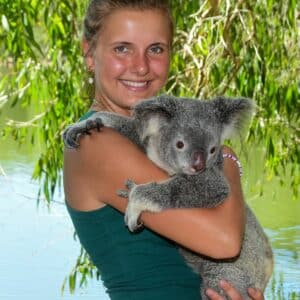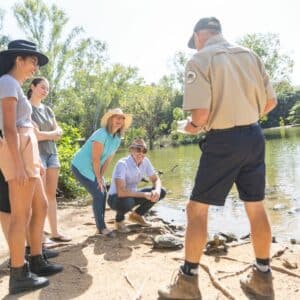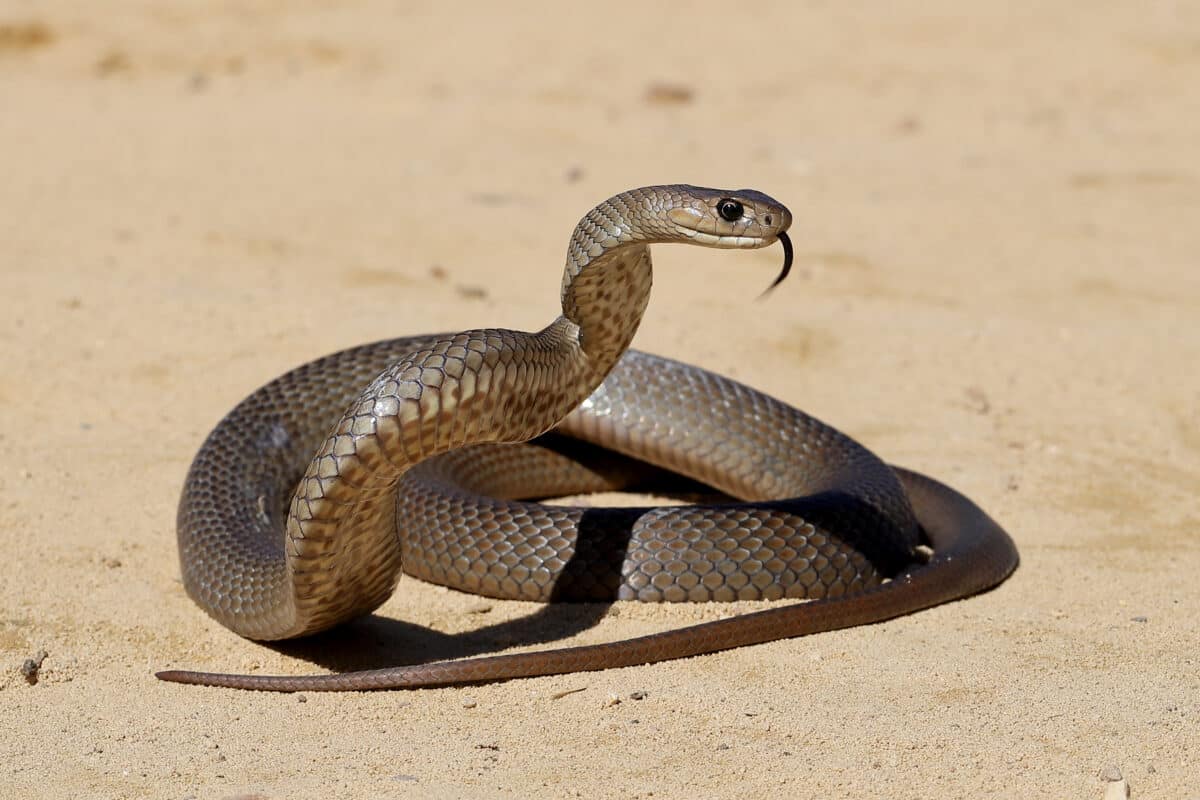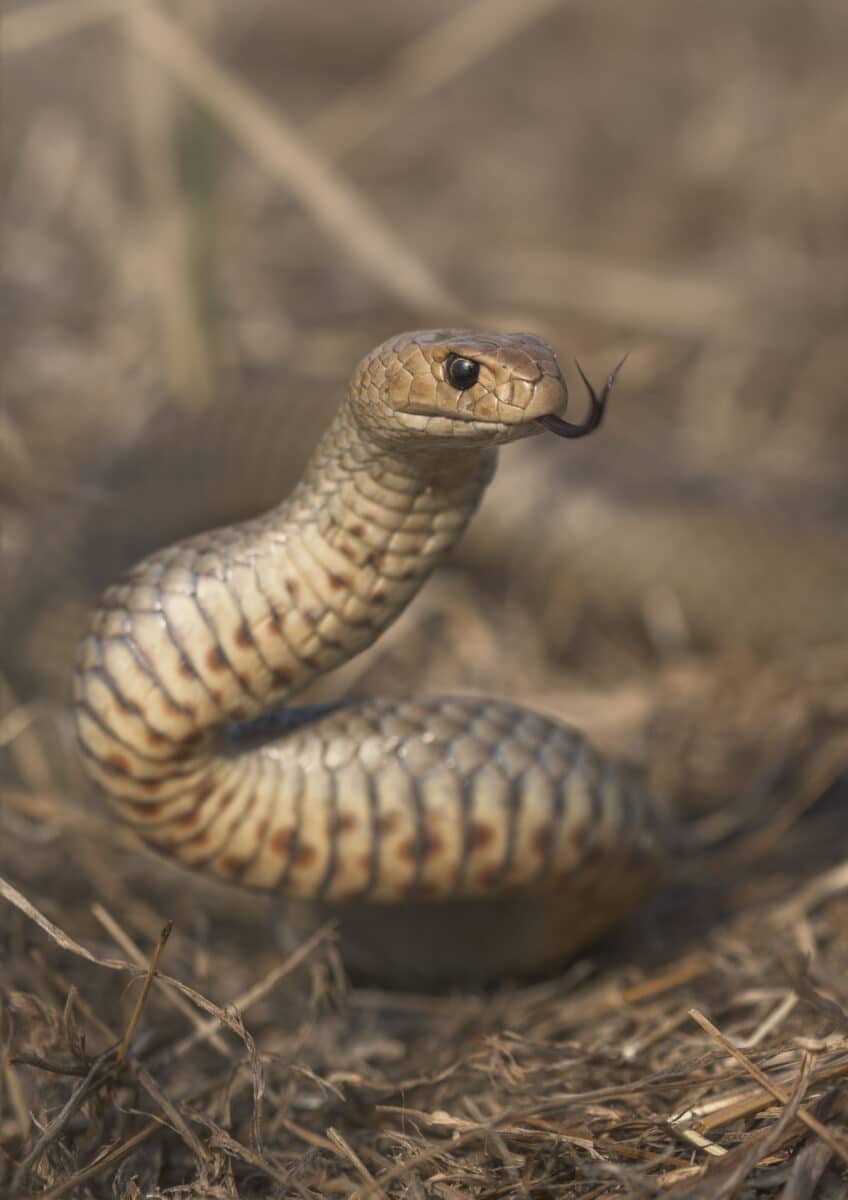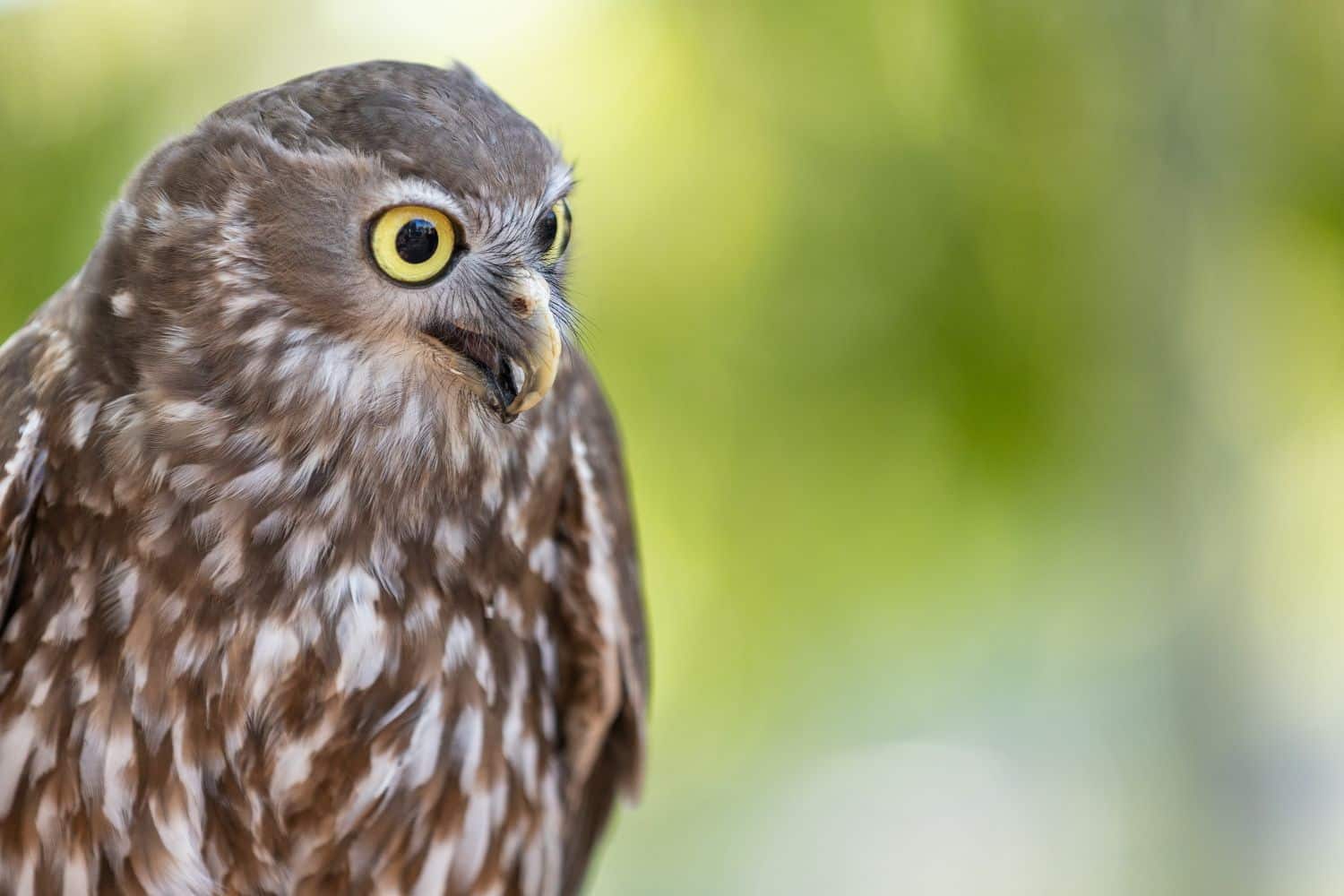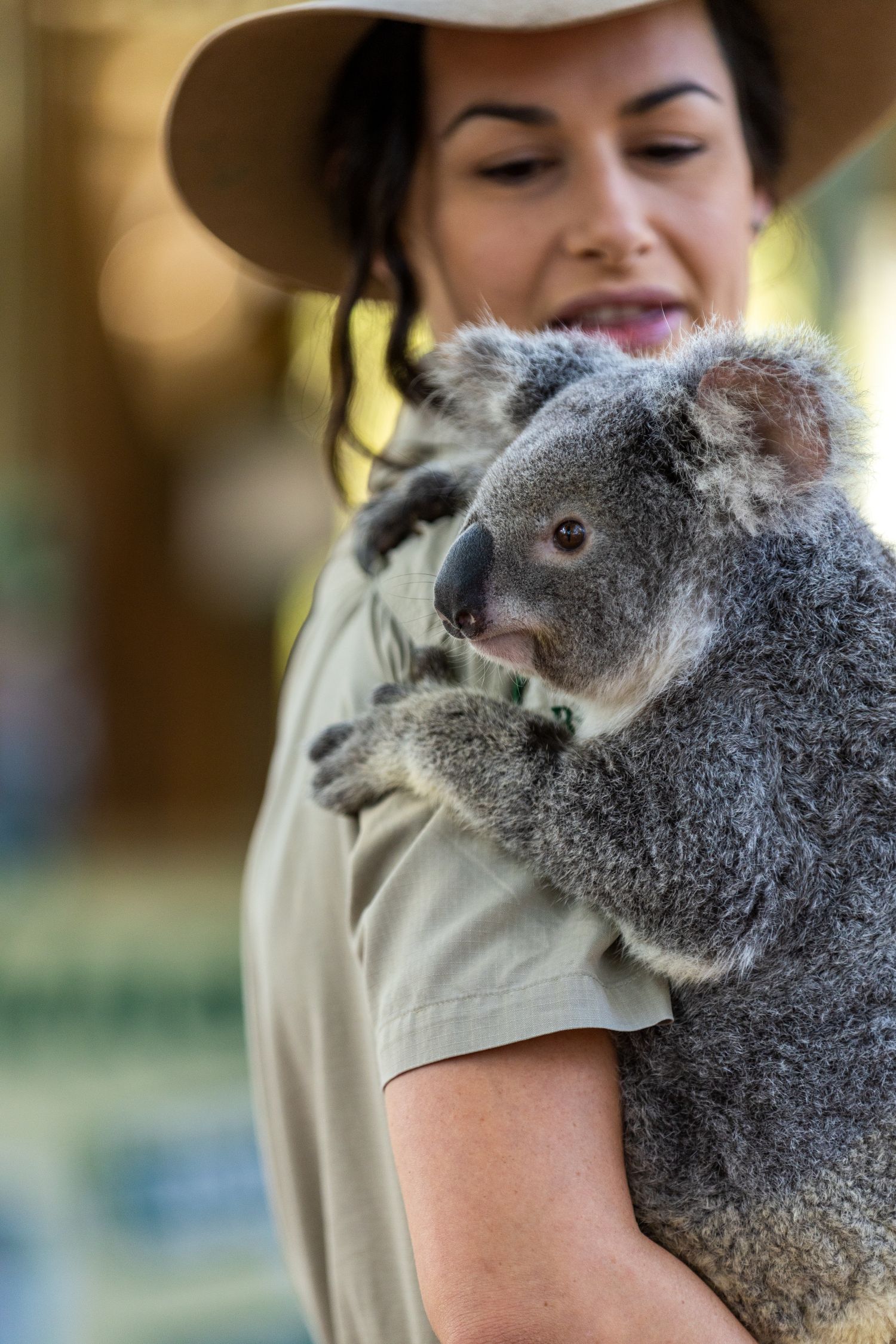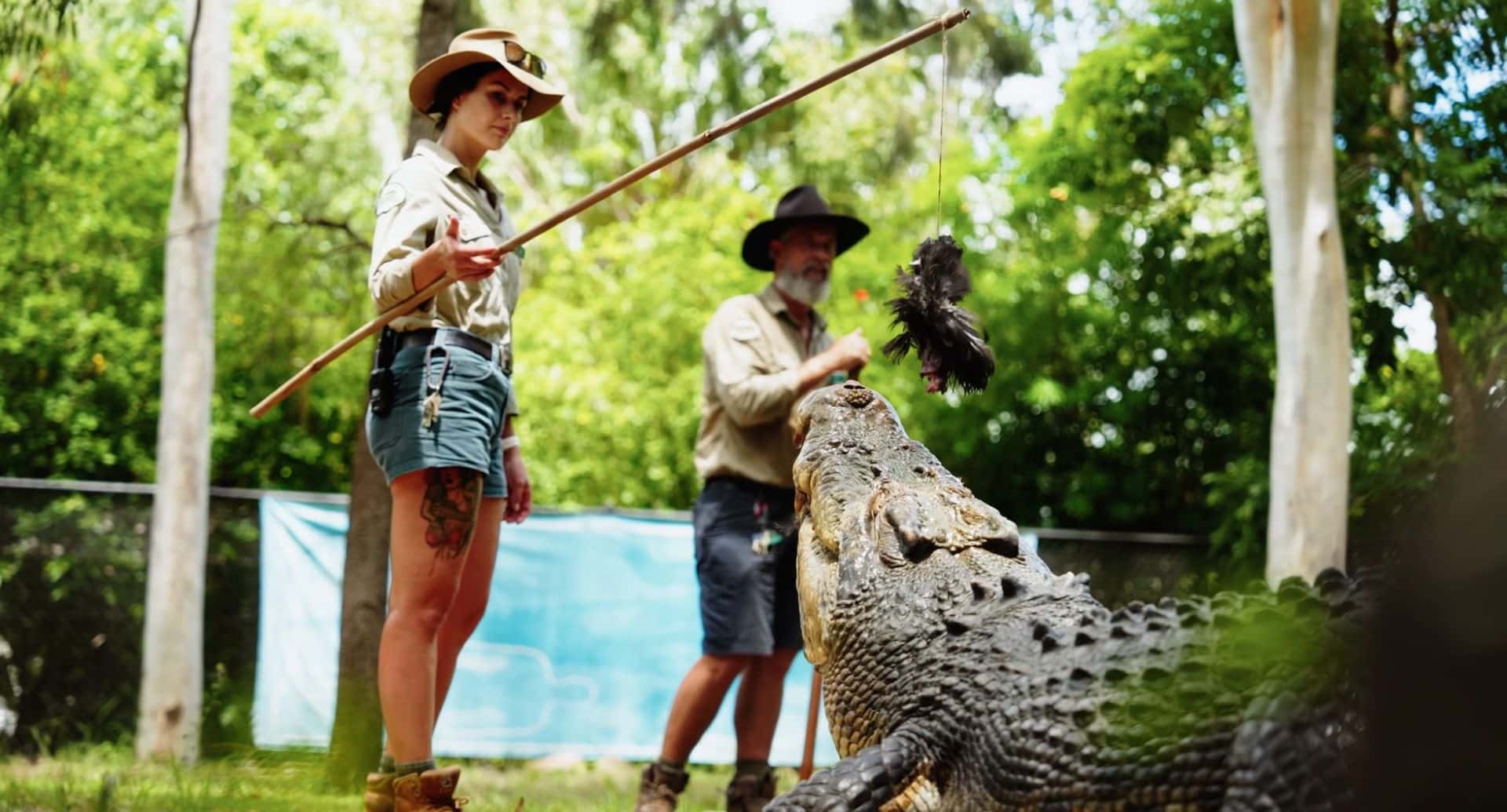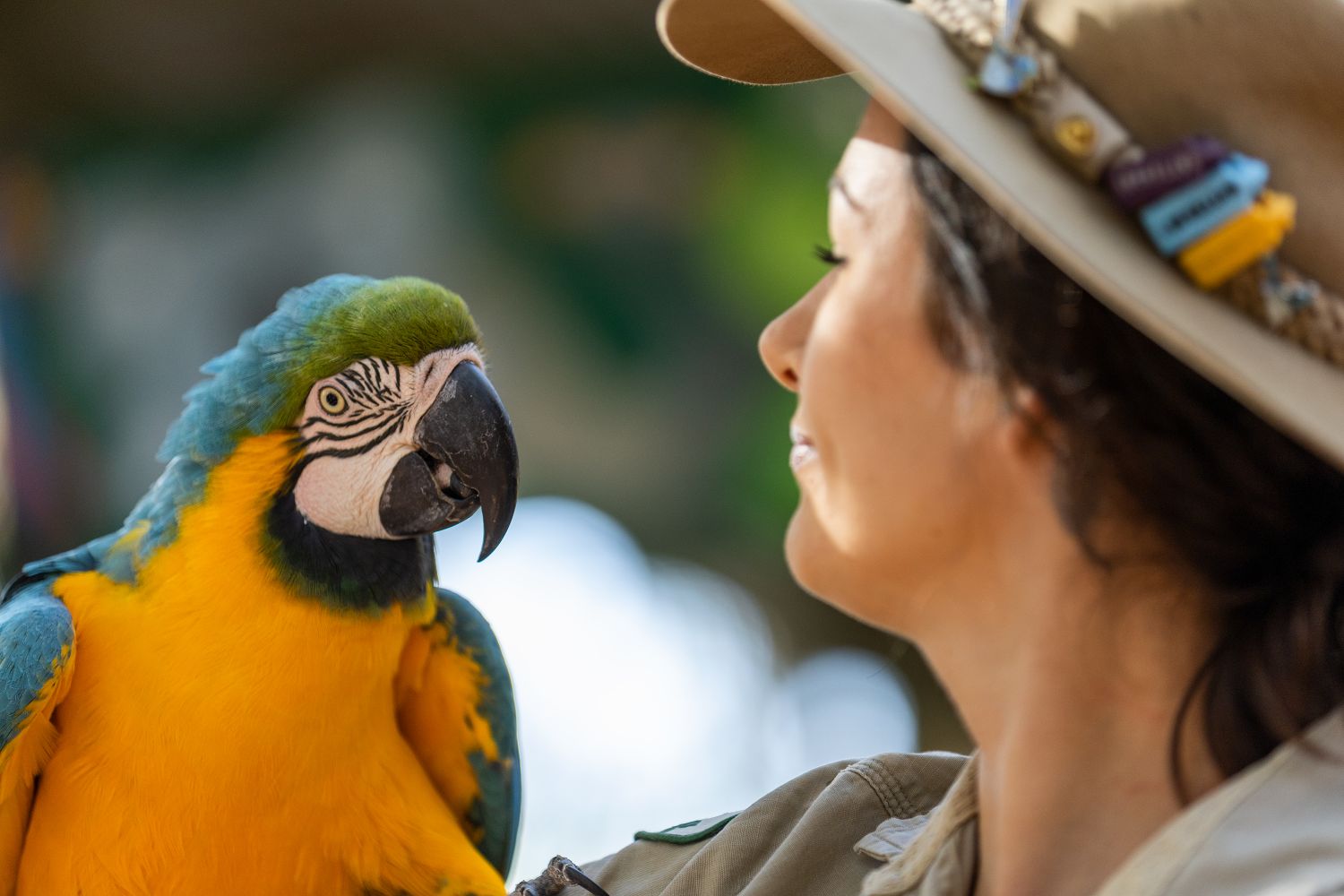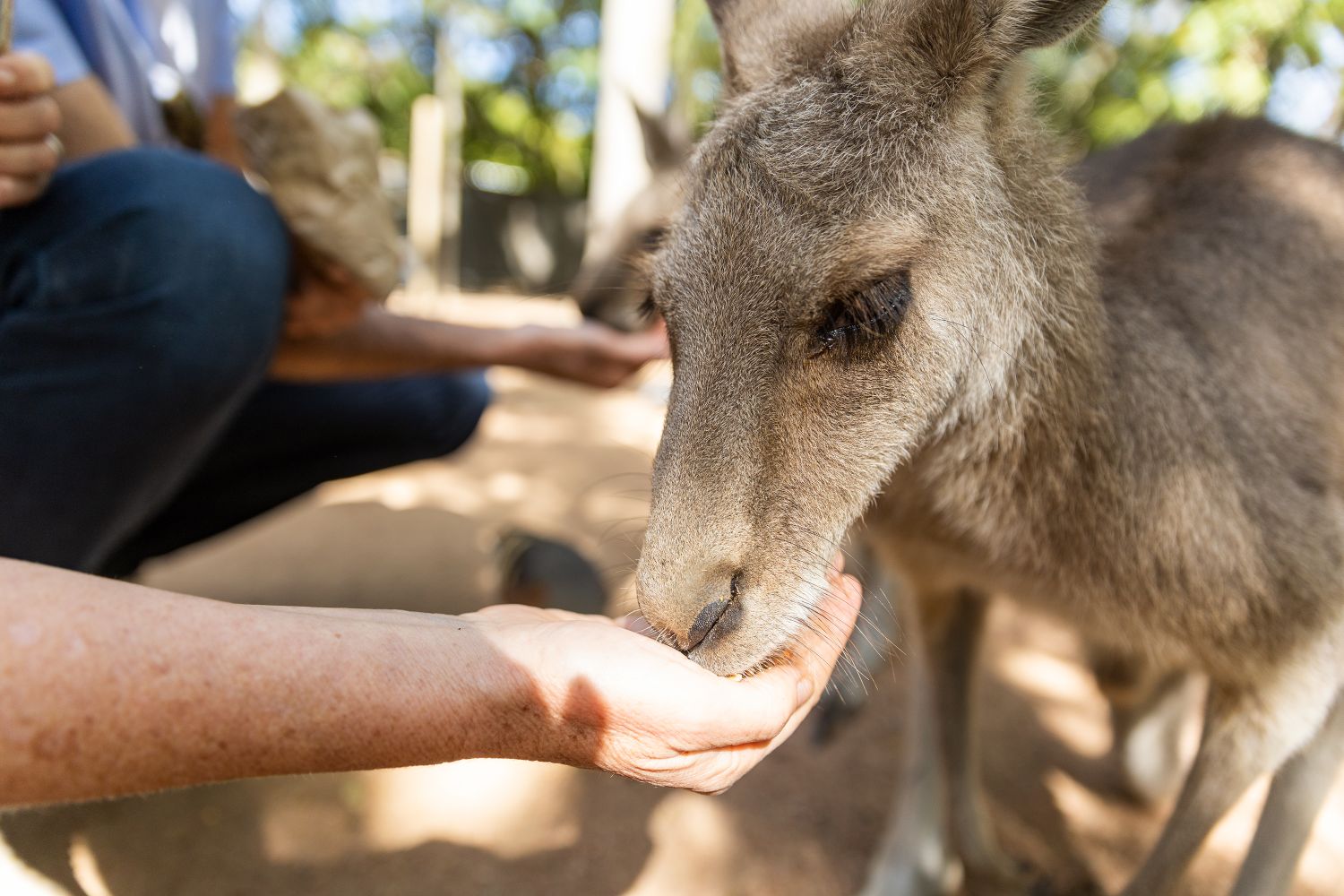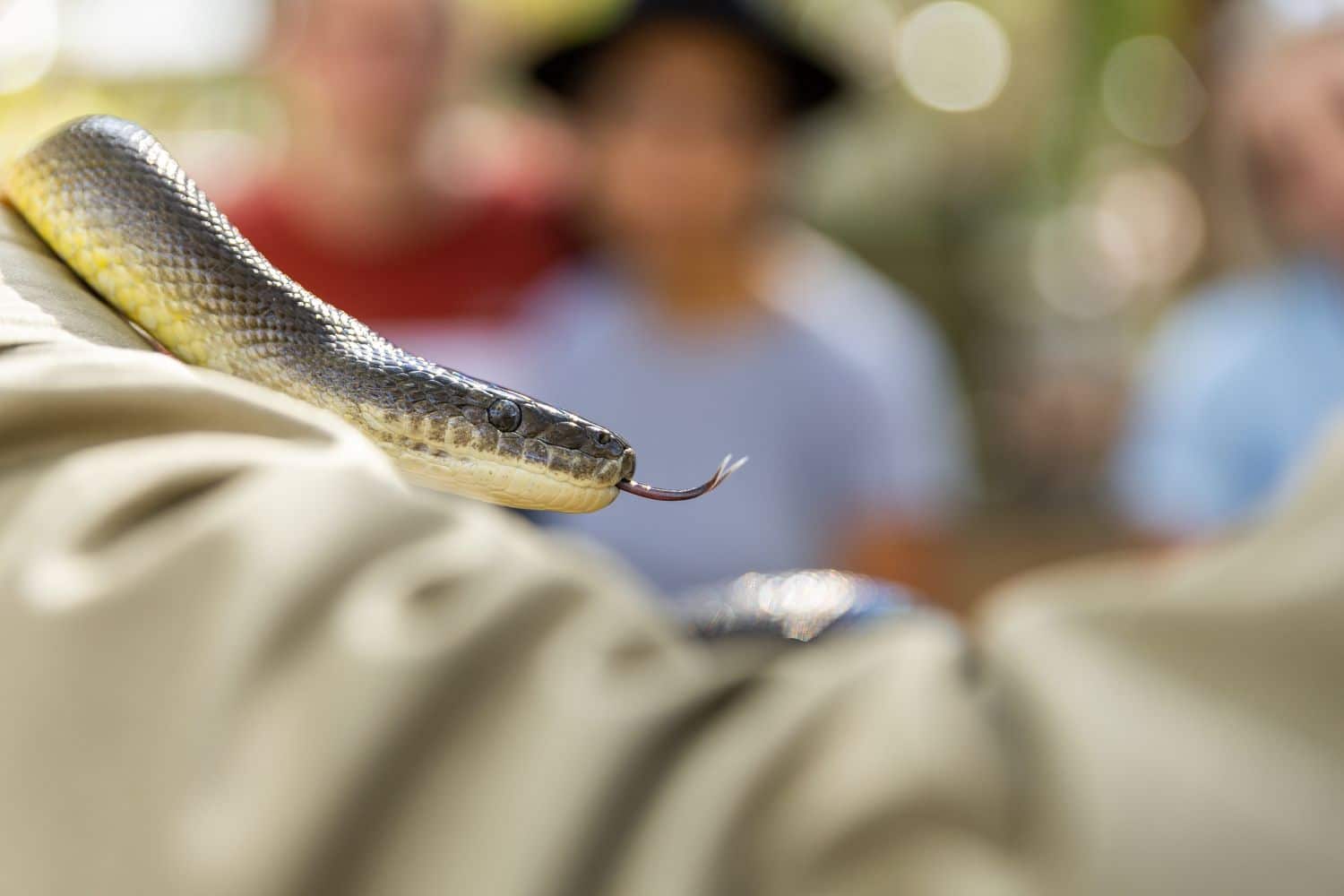One of these is the Eastern Brown Snake, rated by most standards as the snake with the second most toxic venom in the world.
In spite of this, snake bite fatalities in Australia are actually very rare. More people get killed in this country by honeybees than by venomous snakes!
Rather than fearing these awesome reptiles, we should try to understand their amazing adaptations for life in the Australian bush.
WHAT’S IN A NAME?
The genus name Pseudonaja is from the Greek word ‘pseudis’ meaning ‘false’ and from the species name for cobra, ‘naja’, so it means ‘false cobra’. This could refer to the behaviour of the brown snake when threatened: Like a cobra, it will raise the front part of its body, flatten and inflate the neck area, and sway from side to side.
The Eastern Brown is not a cobra but is a member of the elapid family of snakes (venomous snakes with fixed fangs at the front of the jaw).
Tracing the word ‘naja’ to its origins takes us to the Sanskrit language; naga is the Sanskrit word for serpent.
The species name ‘textilis’ is a Latin word meaning ‘woven fabric’ and refers to the reticulated [net-like] pattern of dark-tipped scales often seen on the back of the snake
Put it all together, and the scientific name means: ‘woven false cobra’.
This snake is also known as the Common Brown Snake.
WHAT DOES IT LOOK LIKE?
As is true for most Australian snakes, the colour is highly variable, and cannot be used to identify this species. There are many Australian snakes which are brown-coloured, and the Eastern Brown can vary from very pale brown to reddish or almost black in colour. The only reliable way to identify most snakes is by counting the rows of scales across the back in mid- body, and noting the pattern of scales on the head and under the tail.
This is rarely practical when you glimpse a snake darting away from you in the bush.
Knowing a little about both its appearance and its behaviour, especially compared to other snakes in the same area, not only helps to avoid an unwanted encounter, but deepens our understanding and appreciation of these fascinating reptiles.
The colour of the scales varies, but in general adult Eastern Brown Snakes are a uniform pale to dark brown above, although they may be black or even orange. The belly is cream, yellow or orange, with characteristic orange or dark grey blotches. These can be seen if the snake is close enough to feel threatened, and raises its head up off the ground.
If poised to strike, the snake will coil its body into an S-shape.
Juveniles are even more variable in colour; the top of the head is usually black, with a red or orange stripe just behind this, followed by another dark band. The rest of the body is often striped with dark grey or black. These stripes fade over the next few years as the snake matures. Some juveniles have no stripes, but have darker tips to their scales, giving a reticulated appearance.
The Eastern Brown Snake has a slender body, with a short, rounded head, indistinct from the neck. This distinguishes it from the Taipan, which has a long tapering head, with a definite ridge over the eye, and from most pythons, which have a head distinct from the neck.
It is active during the day, and is terrestrial. Brown Tree Snakes, which are also a coppery colour, usually hunt at night, often climb trees, and have a slender neck with a distinct head.
Like most other snakes, the Eastern Brown will avoid a confrontation with a large animal such as a person, fleeing rapidly towards shelter instead. Studies both in the field and the laboratory have shown that a defensive strike is made only as a last resort.
The average length is about 1.5 metres (4.9 ft), but Eastern Browns can grow up to a formidable 2.4m (7.8 ft) in length. Males grow larger than females.
WHERE IS IT FOUND?
The Eastern Brown Snake lives throughout the eastern half of Australia, except in Tasmania. It is also found in Papua New Guinea.
It will live in most habitats except rainforest. It is particularly prevalent in open grasslands, pastures, and woodlands. Eastern Browns have readily adapted to farmed, grazed, and semi-urban environments. Because of this, they come in contact with man frequently, and account for most of the recorded snake bites in Australia.
The Eastern Brown shelters in hollow logs, rock crevices, unused animal burrows, and under rubbish around buildings. It is an agile, fast-moving snake, hunting by day and returning to its burrow at night. During winter, it remains in its burrow for up to 4 ½ months. Adult males are always solitary.
WHAT DOES IT EAT?
Eastern Brown Snakes eat small vertebrates, mainly mammals, frogs, birds and reptiles such as skinks and geckoes, as well as other snakes.
They have developed a preference for introduced rodents such as rats and house mice, and so are useful predators around farm buildings such as hay sheds.
ADAPTATIONS FOR THIS DIET
Eastern Brown Snakes detect their prey by sensing movement and odour. They seem to have better vision than other snakes. They flick their forked tongue rapidly in and out of the mouth, ‘tasting’ the presence on the air of potential prey animals. This chemical information is passed to the Jacobson’s organ in the roof of the mouth, and then to the brain.
The lean muscular body allows the snake to travel fast in pursuit of its prey. It strikes quickly, bites its victim, and coils around it till it dies. The extreme toxicity of its venom means that the prey animal will die quickly, reducing the danger that it could injure the snake by scratching or biting.
Here is part of the answer to why Brown Snakes have such toxic venom: they eat fast-moving prey which also have sharp teeth and claws, so they must strike fast and strike hard to immobilize the victim as quickly as possible.
Now the snake is faced with its meal—possibly a lizard or large rat—that is many times larger in diameter than its own body. Snakes can’t rip their food apart, so they need to swallow their victim whole. This is a formidable undertaking! Imagine you or me having to swallow an entire melon without chewing it into bite-size pieces!
Snakes have amazing adaptations that allow them to swallow their prey whole:
First, they nudge the victim until it is correctly aligned so that they can swallow it head first. That way, they are not going against the grain of fur, feathers, scales or spikes of the prey animal.
The two halves of a snake’s lower jaw are not fused in the middle, but are held together by flexible muscles and ligaments. This allows them to stretch incredibly far apart as the snake is swallowing.
The upper and lower jaw do not ‘unhinge’ as is commonly believed. Instead, the food passes below this joint along the bottom of the neck, which can stretch enormously around the prey animal.
In order to move the food along, the snake grips it with the fangs on alternate sides of the jaw, moving one side of the jaw and then the other along the prey, passing it down its throat. During this process it produces huge amounts of saliva to lubricate the prey as it moves along.
The ribs of a snake are not anchored to a breastbone (as in other animals, including people) so the tips of the ribs can stretch apart as the food moves on down the snake’s body.
The skin of the snake is also very stretchy. This enables the body to expand hugely as the food item is swallowed.
It can take several hours to swallow a large animal. After eating large prey, the snake will usually spend much time basking in the sun to maintain a high enough body temperature to digest the meal. Powerful enzymes in the venom speed this process by breaking down the tissues of the prey animal.
The ability to swallow very large food items means that a big snake need not expend energy on frequent hunting activities. It may need to eat only a few meals every year.
SNAKES IN LOVE: BREEDING BEHAVIOUR
Early in springtime, male Brown Snakes emerge from their winter shelters in search of a mate. If more than one of them encounters the same female, these rival males will engage in spectacular competitive behaviour called ritualistic combat. They entwine their bodies like writhing strands of a rope, while each try to force the other’s head down to the ground. This struggle may last for hours, until the stronger male finally wins the right to mate with the female.
If the female is receptive, he rubs his chin up and down her body, then twists the lower part of his body under hers. Males have two sex organs, called hemipenes, but only one at a time is used for mating. Mating may last for several hours, and a female may mate with more than one male during the breeding season.
Females lay up to 35 eggs in spring or early summer (November to January). Average clutch size is about 16 eggs. Older females (which are larger) lay more eggs. The eggs are oval in shape, with a leathery shell, and are laid in an abandoned animal burrow close to the winter burrow. The nest site must be damp because right after they are laid the eggs absorb a large amount of water which the embryo needs for development. Females remain in the nesting burrow for up to 5 weeks after laying their eggs, possibly defending them against predators such as lizards or mice.
Several females may lay their eggs in the same nest site and return year after year to use the same location. If conditions are favourable, the female may lay a second clutch of eggs later on in the summer.
Hatchlings emerge about 11 weeks after laying; they average about 270 mm in length (11.25 in).
JUST HOW DANGEROUS IS IT?
The venom of the Eastern Brown Snake is rated as the second most toxic of all snake venoms in the world, next only to that of Inland Taipan (which is also a native of Australia).
The venom of an Eastern Brown Snake contains a cocktail of poisons. The most powerful ingredient is a neurotoxin, which paralyses the nerves of the heart, lungs and diaphragm, suffocating the victim. It also contains a powerful procoagulant.
The accepted standard for comparing the toxicity of snake venoms was devised in the 1970s by the Commonwealth Serum Laboratory (CSL) in Melbourne. Tests were done by injecting live mice, and measuring the amount of venom required to kill 50% of test animals, yielding a number called LD50 (or Lethal Dose 50): the lower the number, the more toxic the venom The LD50 of the Eastern Brown is 0.053mg/kg. Expressed in other units, a single bite could kill nearly 200,000 mice.
The actual number for any particular snake doesn’t really mean all that much (except to all those mice!): dead is dead. The relative danger of venomous snakes depends on many other factors, such as the amount of venom injected, the length of the fangs, the sensitivity of the victim to the toxin, and the likelihood of getting bitten in the first place.
Brown Snakes have relatively short fangs compared to some other non-Australian species such as cobras and vipers. Although they will bite repeatedly if provoked, they inject only a small amount of venom — about 4mg (less than one-thousandth of an ounce). This is more than enough to kill a person, but they will not deliberately seek out and bite humans. There is no advantage to attacking an animal so much larger than itself.
Defensive bites are often ‘dry bites’; that is, no venom is injected.
Despite being home to so many species of venomous snakes, Australia records only about five deaths from snake bite per year. More deaths are caused by horses, or even bee stings, than by snakes.
By contrast, venomous snakes such as cobras and vipers cause many thousands of deaths per year in the very densely populated continents of Africa and Asia.
Most of the lethal snake bites recorded in Australia have been from Eastern Browns. They have learned to hunt rats and mice around farms and cane fields, and so tend to come in contact with humans more often than other venomous snakes.
Most snakes bites occur when someone is trying to kill or catch a snake.
Studies in the lab and in the field have shown that a Brown Snake prefers to retreat or remain stationary if approached by a human, and will bite only if it feels threatened.
So, although the Eastern Brown Snake is indeed highly venomous, a common-sense approach to this and other snakes means that man can share their environment without feeling threatened. If we leave them alone, they will leave us alone.
FIRST AID
Anyone out and about in the Australian bush should carry a couple of broad elastic pressure bandages and become familiar with first aid procedures for any snake bite.
All Australian hospitals and medical clinics carry specific antivenes, as well as kits that enable the staff to identify the type of snake by taking a swab of the bite site. It is not necessary to kill or capture the snake in order to identify it. You are just putting yourself at added risk of being bitten.
STATUS IN THE WILD
Eastern Brown Snakes are abundant and are not considered endangered. They have adapted well to human settlement, learning to hunt introduced rats and mice around farms, and so may play a significant role in controlling numbers of these pests.
Like all Australian snakes, they are protected by law. In Queensland the Nature Conservation Act (1992) prohibits killing or capturing wild snakes unless life is threatened. Any snakes in captivity have been bred and sold by licensed breeders.
The Eastern Brown is an awesome predator, beautifully adapted to its place in the Australian bush. It deserves our healthy respect.




